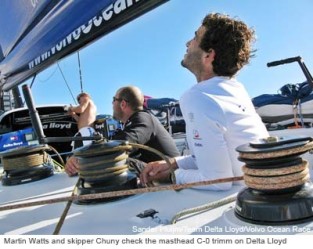As the gloom of the Doldrums is put behind them the fleet march on India
The crew spirit levels are rising again, as the gloom of two days in the Doldrums begins to lift. Now the fleet looks forward to the slow march to Cochin, India.
When an email arrives in race HQ’s inbox with a subject line of ‘Good morning from Ericsson 4’ you know that moods have taken a swing for the better.
Ericsson 4’s bowman Ryan Godfrey reported to Volvo HQ: “Warm times aboard today as we leave the rain clouds of the Doldrums and head into clear blue skies.”
“Several of the boys have moved their mattresses up on deck now in the hope that sleeping temperatures are slightly more bearable than down below. The boat is humming to the sound of our little bunk fans desperately trying to get some airflow happening below decks.”
“Race wise, 665 miles to go – similar to a Sydney-Hobart race, but at six knots of boat speed, the finish is looking a long way off. Spirits are still high and the conversation has turned to what lay ahead for us at the Cochin stopover.”
The boat speed Godfrey mentioned had slipped to two knots by the 16:00 GMT (28 November) Position Report for Ericsson 4 as they continued to cling to their lead. Their pursuers, meanwhile, battle squalls and clouds with no trace of silver linings.
With just 12 miles separating the gang of five behind E4, places are being regularly traded. Telefonica Blue ( 72 Distance To Leader) gained two places in the last three hours jumping both Ericsson 3 ( 81) and Green Dragon ( 86) who are third and fourth respectively.
Delta Lloyd ( 88), still making inroads, is now ahead of PUMA ( 93). The cat was stopped in its tracks by ‘bad clouds’ – a cost of 15 miles and two places. “I was told this Doldrums place could be a real killer, but I had no idea it could be this bad,” said PUMA skipper Ken Read. “Believe me, we aren’t trying to sail in the bad clouds, just the opposite. We were in a virtual pinball machine of bad clouds.”
 Delta Lloyd’s navigator Matt Gregory reported:
Delta Lloyd’s navigator Matt Gregory reported:
“After 12 days of racing over 4500 miles we are now 60 miles south of the equator and 700 miles due south of the Leg 2 finish line in Cochin India. Unbelievably, we can see 3 other boats; Ericsson 3, Green Dragon and Puma. Green Dragon is so close to us that I can hear that they just turned on their generator to charge the batteries that run their onboard systems. There is a light purr echoing across the water as we all sit, bobbing like corks, perfectly still. The guys in their bunks are peacefully rocked to sleep as water laps up against the hull of the boat.
This is stark contrast to where we were last week. A week ago I wrote about fear. 10 meter waves, gale force winds, cold, violent boat motions that seemed like the boat could break in half at any minute, and deafening noise inside of our carbon racing machine. It seems like a long week ago and so many things have happened since then.
This race has progressed at a wickedly fast pace, from Cape Town, through the Southern Ocean, up into the Indian Ocean and through the sub tropical trade winds. The past 48 hours have brought about an epic battle of tactical wit and relentless crew perseverance. We crossed the doldrums. This area between the trade winds and the equator that is notorious for shifty winds by day and rainy squalls by night. As a navigator these are some of the most difficult waters to sail through anywhere on the planet. My time is consumed, both, analyzing weather data, down in the boat’s navigation desk, and working on deck with night vision goggles and compass in hand to visually track rain clouds.
Each cloud can provide the wind to make significant gains on the competition. The crew has been working tirelessly to keep up with these dynamic micro-weather systems. Just like each golf club is designed for a particular type of shot, each sail fits into its own wind speed and angle. As we’ve transitioned from cloud to cloud we’ve had to reach into our 11 sail quiver to select and then transfer to the optimum sail. Each sail weighs about 150 kg. Changing them over and over and over again, every 30 minutes, is exhausting.
We have only 700 miles to go to the finish. At our pace from the first part of this leg, where we were logging over 500 miles per day, we’d feel like we were practically there. However, looking at the weather models, 500 mile days will have to wait for an upcoming leg. Light and variable winds are in the forecast so Cochin still feels like a far away land. The racing is close and almost anything can happen. The race could be won or lost on a small zephyr of wind on our starry moonless night. We’ll keep the pressure on.
At the tail of the fleet, Telefonica Black ( 154) out west, and Team Russia ( 187) to the east, have swapped places. For the navigators, the skies above have been clouding their judgement and respite from the tactical intensity of the past 48 hours is long overdue. For Team Russia’s Wouter Verbraak, it has been all about ‘cloud chasing’:
“The Doldrums are making themselves felt with huge squall systems followed by dead calms. Think the Atlantic Doldrums are a challenge? Try these for a laugh.”



